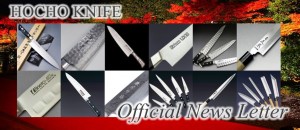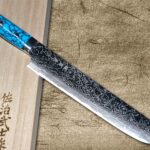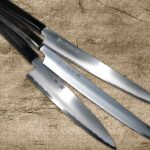A customer gave us a complaint about trouble at the tip of a kitchen knife,
“I have restored a broken tip on a Damascus hammered knife. I have 3 such knives, and it is possible to bend the sharp tip through regular kitchen use. Not by dropping the knife…
If you try to hammer the bent tip back into being straight – it breaks. It breaks because the steel is hard, brittle and not flexible. So much for Japanese skill in making hard and flexible steel!
The restored tip is not as sharp as on the original. The super sharp original tip is very thin at the end, hence it bends easily. After the owner tries to straighten it out, it breaks.
I think you need to spend more time using your products (knives) in the kitchen, then you will discover their strength and weaknesses.
The knives you sold me can be improved, however you blame the owner for inappropriate use.
Sincerely”
We fully understood his feeling of course, and were grateful to his gutsy email.
But there was an important thing to let him know. We replied as follows, really hoping that he will use Japanese knives in more proper manner.
———-
Dear xxxxx,
Thank you so much for the excellent advice.
It is normal that the blade thickness of Japanese knives is thinner than those made in Western countries, because the culture of cooking is basically different.
Most Japanese knives fits for slicing (or slidingly cutting) foods like sashimi, on the other hand kitchen knives made in Western countries do for chopping (hacking) food like chicken. We’re afraid that such bentness may occur only when twisting or hit the tip in something hard.
We recommend you to use “Deba” knives which are stronger than other type of Japanese knives. Deba is developed for slaughter fish so that you can cut even fish bones. The blade is much stronger and thicker than other type of knives.
Anyway, we’re afraid that It is needed to understand the difference of the behavior of cooking.
Of course as you know, users are needed to prevent knives from cutting something hard like bones and frozen food by the knife, twisting the edge on a board, or dropping it on the floor.
———–
After that, the customer kindly agreed with our opinion.
If you have any question, please feel free to contact us anytime.
Thank you for reading and best regards!
All the Hocho-Knife staff
~~~~~~~~~~~~~~~~~~~~~~~~~~~~~~~~~~~~~~~~~~~~~~~~~~~~~~~~~~~~~~~~~~
“Hocho” represents Made-in-Japan (Sushi / Sashimi) Kitchen Knives,
that is the soul of the cook!
~~~~~~~~~~~~~~~~~~~~~~~~~~~~~~~~~~~~~~~~~~~~~~~~~~~~~~~~~~~~~~~~~~

mport Japan.com,Inc.
Florida, USA
Kyoto and Hyogo, JAPAN








